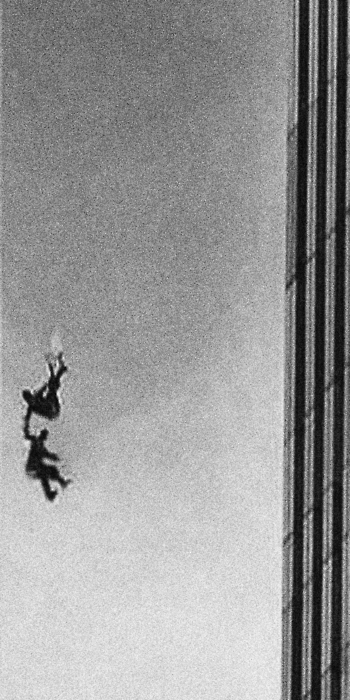An integral part of our work ethic is establishing narrative and theme through movement and dance. As such, this notion has established the strong collaboration that must exist between director and choreographer. As a creative partnership, Laura and I decided that the ‘Falling’ image (see below) taken at the 9/11 terrorist attacks would be shown through a collection of dance and movement sequences.

I believe that movement and phrasing should stem from an improvisational approach. With this in mind, I asked the company to take the image and utilize the patterns and shapes evident in the photograph, as well as take pre-existing moves from earlier workshops. Louppe tells us, “Improvisation is, like composition, an indispensable element of contemporary dance” (2010, 160). An important part of being choreographer is to notice the relationships and dynamics forged in these type of sessions, and to recognize that ideas and phrases can be discovered when the whole ensemble is involved in the devising process.
“[A] characteristic of creativity in contemporary choreography cognition is that the dancers and choreographer increasingly work together exploring, selecting, and developing dance material” (McKechnie and Stevens, 2009, 40). Therefore, even though I had final say as choreographer, the artistic process of developing and crafting material comes from the b0dies of your performers and their ideas being put into practice. Initially, I saw the image as a group routine. The routine would capture the emotions, fear and trauma of that fateful day, and I would use the image to explore those situations. The four main factors I considered were:
- Reach
- Connections
- Tilt
- Gravity (pulling/pushing down)
In this sense, the dance sequence would highlight this specific image, but, it would also connect and reaffirm the recurring motif of relationships and physical connections. Louppe says, “It is the dancer who reveals the powerful source of the imaginary” (2010, 55). Therefore, to evoke the sense of loss and empathy, as a group we had to work closely with intention and focus; if we could see the plane coming towards us, or embody the sense of falling, the audience would hopefully see and feel this too. It was in our hands to recreate the amalgamation of thoughts and feelings present in that drastic situation. The movements came quite naturally: reaching forward, tilting, stumbling, leaning. My inspiration came from existing work such as Freedom (2013) by Jasmin Vardimon and commercial choreographer, Mia Michaels. The latter works heavily with choreographing loss and empathy.
The visual impact of this photograph extended to create an entire stage picture. After one company member likened the falling pair to Peter Pan and his shadow, I worked closely with Mark and Morgan to develop a Pas de Deux to express and explore this notion. Did this pair know each other? Or, did they just hold hands and jump? As much as this duet exemplified the idea of falling, the routine also suggested a feeling of euphoria and freedom; the vocation to address and reminisce of people being together in horrific situations, of couples and relationships shining through from the darkness. “The power of movement and dance to evoke memories has been identified as an important factor in communication” (McKechnie and Stevens, 2009, 45). Although this dance expressed what I believed to be contained in that image, the movement can also transcend this inception and comment on other disasters; global or personal.
Please see ‘Choreographic Notes’ under Documents > Technical > Choreography, or click here.
Please see Gallery for more rehearsal photos, or click here.
Works Cited
Figure 1. The Death Posture (2013) [Photograph] At: http://timeconsumerrr.tumblr.com/ [Accessed 6 March 2015].
Louppe, L. (2010) Poetics of Contemporary Dance. Translated by Sally Gardner. Hampshire: Dance Books Ltd.
McKechnie, S. and Stevens, C. J. (2009) Visible Thought: Choreographic Cognition in Creating, Performing, and Watching Contemporary Dance. In: Jo Butterworth and Liesbeth Wildschut (ed.) Contemporary Choreography: A Critical Reader. Oxon: Routledge, 38-51.
Michaels, M. (2015) So You Think You Can Dance Photography [online] Available from: http://miamichaels.com/photo/so-you-think-you-can-dance/ [Accessed 10 April 2015]
![IMG_3858[1]](https://refracttheatrecompany.blogs.lincoln.ac.uk/files/2015/03/IMG_38581-1024x768.jpg)

